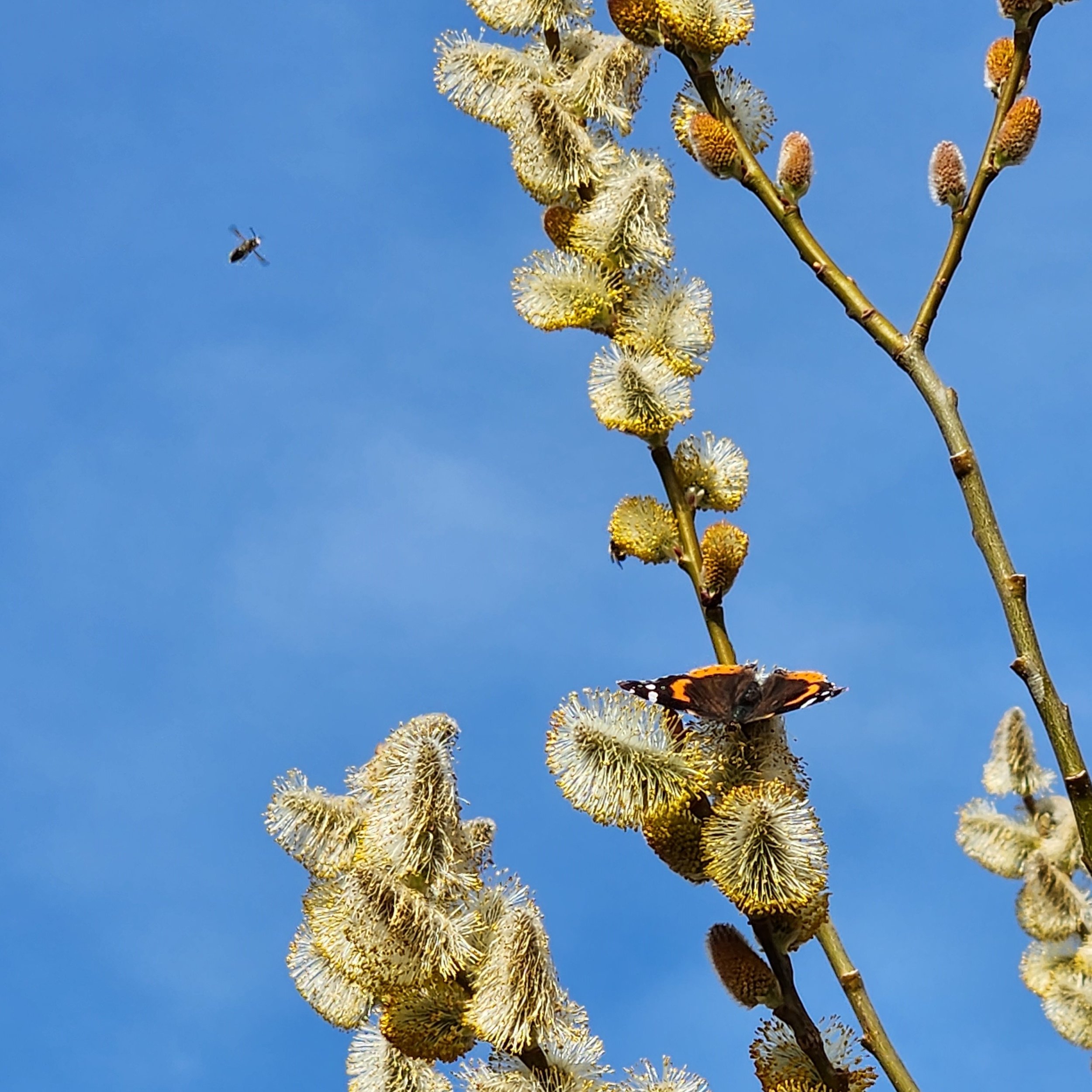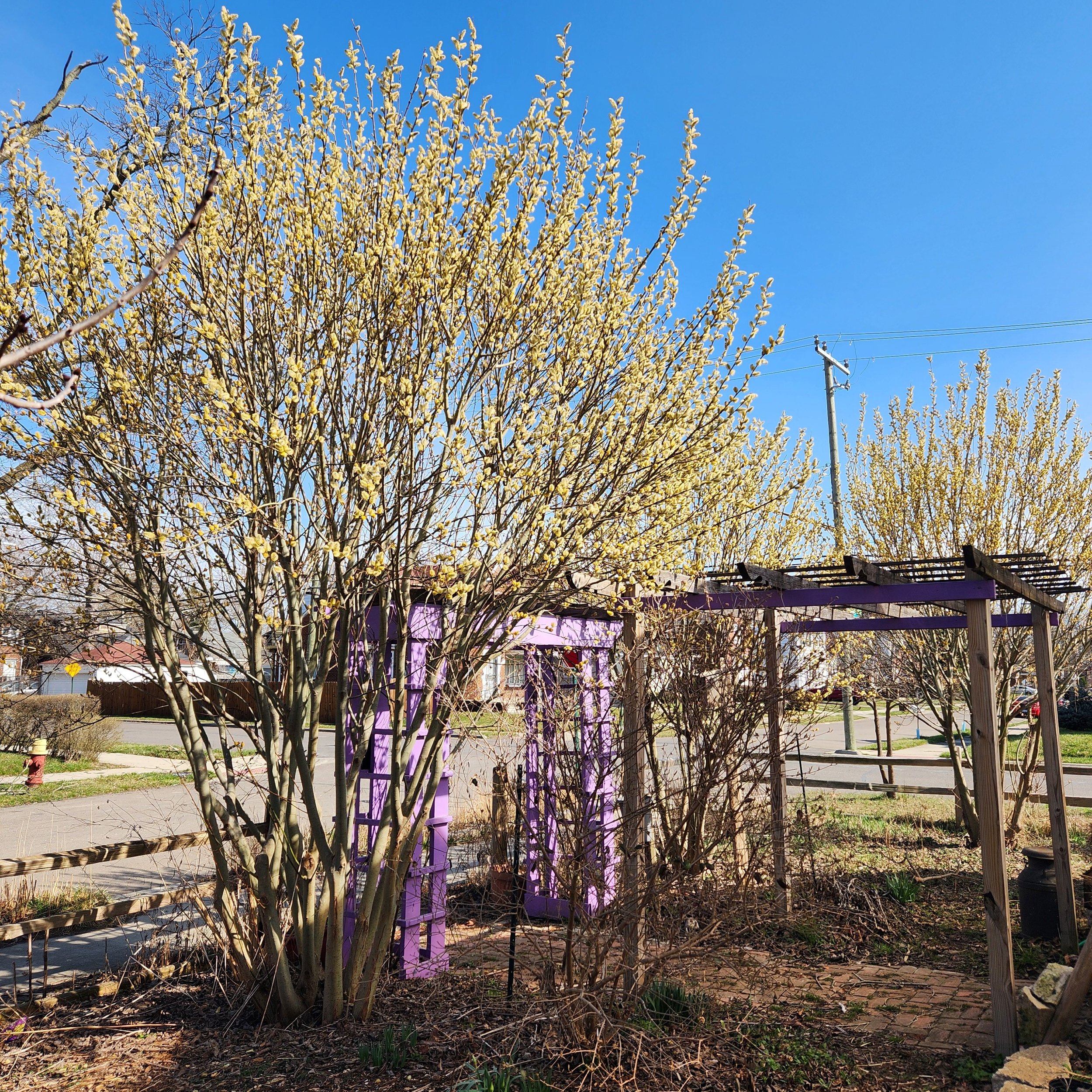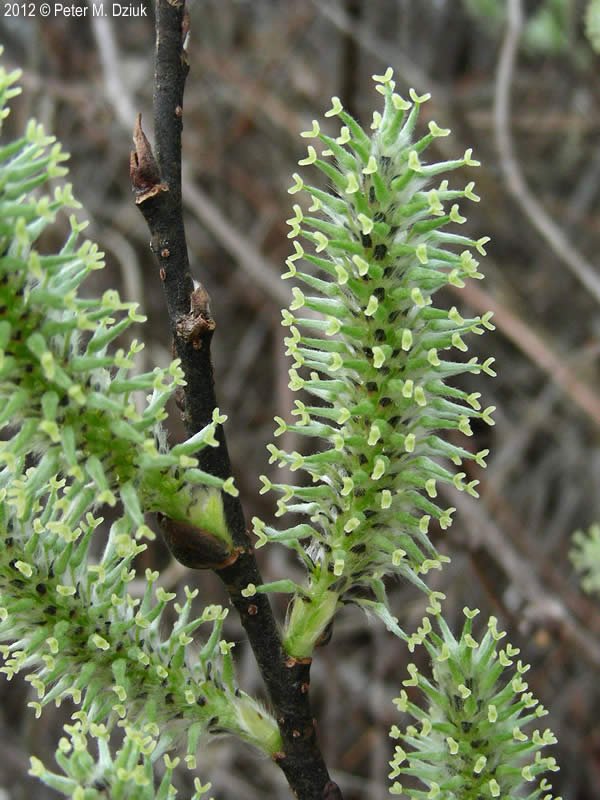 Image 1 of 7
Image 1 of 7

 Image 2 of 7
Image 2 of 7

 Image 3 of 7
Image 3 of 7

 Image 4 of 7
Image 4 of 7

 Image 5 of 7
Image 5 of 7

 Image 6 of 7
Image 6 of 7

 Image 7 of 7
Image 7 of 7








Salix discolor, Pussy Willow, Gallon pot
Salix discolor, Pussy Willow
FS - PS, Zone 3, Blooms April to May, 25’ x 4-10’, wet to medium moisture
This fast growing plant is considered either a shrub or tree. It can be easily pruned to control shape and growth when the plant is young (3-4 years). If left it will grow into a multi-stemmed tree. We planted 8 Pussy Willows (all males) in 2017, 3 at the flower farm and 5 around our hoophouse. Other than cutting branches every spring before the catkins bloom, we have let them be. They are now in 2024, around 15-20’ tall. They do so many things for our gardens. including providing cover for birds, host plant and food for butterflies and specialist bees and simply nice green unassuming foliage.
When grey, furry catkins bloom in early spring you know spring is coming. The fuzzy, silky grey seen on the catkins is actually protection for the tiny florets that will open and provide a much needed early pollen source. They bloom in early spring when the weather may still become cold, and they may the protection. You also know the Mason Bees will emerge soon. The timing provides much needed pollen for the bees. Red Admiral butterflies also appear about this time. It seems dependable and that is a good thing and why Salix discolor is considered a keystone plant. Salix genus is #3 on the Keystone Shrub/Tree list. There are about 20 species of Salix (Willows) in Eastern North America. This plant genus supports 289 species of caterpillars and 14 species of Specialist Bees. Specialist Bees are ones that evolved with certain plants and rely on the pollen from that plant.
The following is taken from Prairie Moons writeup and explains the difference between male and female pussy willows. Pussy Willows are dioecious, meaning the female flowers are housed on separate plants. The female blooms contain nectar, the male plants contain both nectar and pollen. All of our pUssy Willows are male. - “The plants bud out in late winter, often when there is still snow on the ground. Male Pussy Willows are prized for the fuzzy, dove gray buds borne on decorative ruddy red or tawny gray stems. These elongate and form catkins which burst open to reveal streaming, gold-tipped stamens commonly called “pussy fur.” Pussy Willows are beautiful in the landscape as well as floral arrangements. By comparison, the female flower buds are less showy, remaining gray or green - and although the catkins tend to be longer in length, the green stamens lack the peppy burst of yellow displayed by male specimens. If fertilized by a local male Pussy Willow, the female flowers are replaced by intriguing teardrop-shaped fruit capsules displayed along the length of the catkin. Small, dark bracts with gossamer strands develop at the base of these fruits. The cottony seed is dispersed by wind or water. Leathery leaves fill in as the catkins and fruits fizzle out. The foliage makes a soft merge from green to muted yellow in the fall.”
Host plant for the Viceroy, Mourning Cloak Butterfly and many moths. Supports 14 species of specialist bees. Early emerging native bees such as Mining and Mason bees depend on the pollen and nectar for their broods.
REGARDING THE PHOTOS - #5 shows two year old plants, #6 - shows 7 year old trees, #8 is a photo from Minnesota Wild Flowers of a female bloom.
Salix discolor, Pussy Willow
FS - PS, Zone 3, Blooms April to May, 25’ x 4-10’, wet to medium moisture
This fast growing plant is considered either a shrub or tree. It can be easily pruned to control shape and growth when the plant is young (3-4 years). If left it will grow into a multi-stemmed tree. We planted 8 Pussy Willows (all males) in 2017, 3 at the flower farm and 5 around our hoophouse. Other than cutting branches every spring before the catkins bloom, we have let them be. They are now in 2024, around 15-20’ tall. They do so many things for our gardens. including providing cover for birds, host plant and food for butterflies and specialist bees and simply nice green unassuming foliage.
When grey, furry catkins bloom in early spring you know spring is coming. The fuzzy, silky grey seen on the catkins is actually protection for the tiny florets that will open and provide a much needed early pollen source. They bloom in early spring when the weather may still become cold, and they may the protection. You also know the Mason Bees will emerge soon. The timing provides much needed pollen for the bees. Red Admiral butterflies also appear about this time. It seems dependable and that is a good thing and why Salix discolor is considered a keystone plant. Salix genus is #3 on the Keystone Shrub/Tree list. There are about 20 species of Salix (Willows) in Eastern North America. This plant genus supports 289 species of caterpillars and 14 species of Specialist Bees. Specialist Bees are ones that evolved with certain plants and rely on the pollen from that plant.
The following is taken from Prairie Moons writeup and explains the difference between male and female pussy willows. Pussy Willows are dioecious, meaning the female flowers are housed on separate plants. The female blooms contain nectar, the male plants contain both nectar and pollen. All of our pUssy Willows are male. - “The plants bud out in late winter, often when there is still snow on the ground. Male Pussy Willows are prized for the fuzzy, dove gray buds borne on decorative ruddy red or tawny gray stems. These elongate and form catkins which burst open to reveal streaming, gold-tipped stamens commonly called “pussy fur.” Pussy Willows are beautiful in the landscape as well as floral arrangements. By comparison, the female flower buds are less showy, remaining gray or green - and although the catkins tend to be longer in length, the green stamens lack the peppy burst of yellow displayed by male specimens. If fertilized by a local male Pussy Willow, the female flowers are replaced by intriguing teardrop-shaped fruit capsules displayed along the length of the catkin. Small, dark bracts with gossamer strands develop at the base of these fruits. The cottony seed is dispersed by wind or water. Leathery leaves fill in as the catkins and fruits fizzle out. The foliage makes a soft merge from green to muted yellow in the fall.”
Host plant for the Viceroy, Mourning Cloak Butterfly and many moths. Supports 14 species of specialist bees. Early emerging native bees such as Mining and Mason bees depend on the pollen and nectar for their broods.
REGARDING THE PHOTOS - #5 shows two year old plants, #6 - shows 7 year old trees, #8 is a photo from Minnesota Wild Flowers of a female bloom.